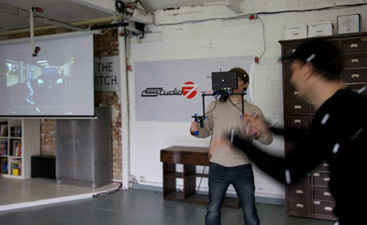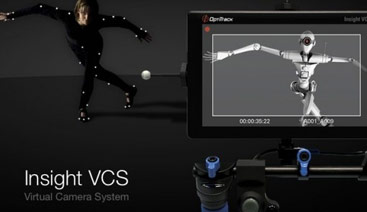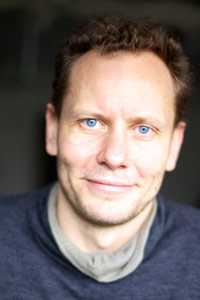Studio 7 launches its state of the art motion capture service with their new Virtual Camera System
Last week Studio 7 officially launched their new Virtual Camera System (VCS) and invited Skwigly’s Joe Gammie down to see what all the fuss was about…

Hidden deep in the heart of London Studio 7 appears at first to be a studio apartment. Located off Shoreditch High Street, down Plough Yard, it is situated in what appears to be an old textiles building. Up the cast iron staircase you go, then through into an open plan studio. Welcoming me were Chris Richmond and his team, all ready to show off their new piece of kit, and it wasn’t a disappointment.
Chris is the director of Studio 7 and Atticus Finch, a well known production company. He told me that the mocap studio came about because they had been renting out their studio space for live action shoots for some time, without realising it would make a fantastic, compact mocap space. Chris explained further that “it seemed there wasn’t a facility in central London that was cost effective for small companies to get involved with mocap. So I thought, ‘OK, here’s a potential gap in the market that is worth both pursuing and investing,’ and that’s what we decided to do.”
To say the space is compact is an understatement. The area they are using for the mocap work is only 10ft by 12ft, with 24 cameras set up to capture the actors movements. It can capture the motion of two actors at a time, and has a separate space for facial mocap and editing. But it is not the mocap itself which sets Studio 7 apart from its competitors – it is their brand new OptiTrack Virtual Camera System, and it is an intriguing piece of kit.
The VCS was born in the early days of Avatar. James Cameron is renowned as a hands-on kind of director, even going behind the camera himself when he wanted a particular shot. When filming Avatar, which relied heavily on mocap technology, he found himself in quite a quandary. Usually, motion capture is done with the actors in their 3D environment. The large team of actors, camera men and technicians will shoot the actors movements and transfer that data into the software to create a 3D rig of the actors within the set parameters. After this the animation team will come in, fill out the details on the rig (texture, colour, clothing etc.), then working closely with the director they will turn the 3D rig into the individual shots the director wants.
This has always been a time consuming part of mocap, the director working very closely with the animators so that he gets exactly the shots he is looking for. For James Cameron this just took far too long, so he started work on developing a system where, as Chris surmises, “he could have the same amount of interactivity with his virtual actors in the green screen environment as he was used to working on live action films.”
 The VCS effectively allows the director to take a camera into the mocap environment, and film the actors from the precise angle that he wants to the shot to be from. This means that when the animators receive the 3D rig from the mocap camera, they already know which camera angles are to be used, and can save time simply rendering the rig without worrying about where the camera should be. Chris explained it like this:
The VCS effectively allows the director to take a camera into the mocap environment, and film the actors from the precise angle that he wants to the shot to be from. This means that when the animators receive the 3D rig from the mocap camera, they already know which camera angles are to be used, and can save time simply rendering the rig without worrying about where the camera should be. Chris explained it like this:
It works with the mocap because you can feed data from the Virtual Camera System, which is essential a rigid body being tracked within your mocap volume, live into your scene. When that data’s within the scene it handles exactly the same way you would handle a live action camera, so you can have it shoulder mounted, it picks up all the rotations, roll and movement you’d actually experience if you were holding a real camera.
This is a real time saver on the production side, whereas previously animators would spend a great deal of time trying to mimic a real world camera into their mocap footage, the VCS allows you actually record the movement of a real world camera straight in there. So if a director is working on a previs he could potentially try out a whole number of ideas for the scene and record them in real time to see what works best for the scene.
It is a very flexible piece of kit. It not only allows you to add a real world camera angles when your recording mocap actors, but can also be used with animatics. As Chris highlights, “it actually means you can essentially go on a virtual walk around your scene using the camera. You can actually be inside your scene in real time. Imagine it as if you’re seeing through the eyes of a virtual character. So you can position yourself using the track, panning and dollying facilities on the camera to have a little look and see that that angle looks really good.”

Chris Richmond – Studio 7
Chris and his team hope that the VCS could potentially act as a bridge between live action and animation:
“Live action directors or directors that work in a cross over area can have that real time feedback from a camera. I think in terms of camera, it is definitely a very tangible bridge between live action and animation.”
And it isn’t just directors who can benefit from the VCS, it is animators as well. If you set up your scene in such a way that you have the background, characters and movements worked out to the time frame required, the VCS allows you to pop that data into the software, creating the environment, then they can use the VCS to pick and do their shots all in one block.
We were shown a demo of the VCS while we were there. It was set in a mock Western scene, with Chris as the mocap actor in the centre. Initially you could see that the 24 cameras around him recreated his movements in the software so that his technician could see how his movements fitted within the scene. This is all perfectly normal, but what happened next was that Andy, the technician, got the VCS and joined Chris in the mocap area. The system picked up the camera, but not Andy, so watching on the screen you could still see Chris and what he was doing and how the two worked together, but you could also see where the camera was placed too. From Andy’s view, he could move the camera within the scene and try out different shots i.e. from behind a barrel, or from the roof of a building, effectively instantly creating a previsualisation of the scene for a director to analyse.
In a previs work,” Chris told me, “the frame for both animation and live action it really is an amazing time saver because commonly in previs the camera moves are very basic, they’re literally one step from an animatic. With the VCS you can actually nail your camera moves pretty much exactly how you want them, so when it comes to live action your camera team can go out and have very good reference to what the director was looking for right from the offset.
In animation, those same cameras can go into the production scenes and if you needed to do any refinement you’ve got the camera there you can use as your base camera for keying, which is the best reference you can possibly have.
What’s more, the software easily fits into existing mocap technology. Chris and his team work off the OptiTrack VCS and mocap system, and feed the data into Autodesk Motion Builder. This is their staging area, where all the data is streamed and they can bring in other CG assets like scene and character. From here you can export into any software of your choice, using the relevant plug-ins.
The OptiTrack VCS is not only a fantastic tool for live action directors looking to get more hands on in the VFX and animation work, nor is it only a useful time saver for animators. It is also an effective way of giving hands-on motion capture experience to students and amateurs alike. In the past, motion capture has relied on large teams collecting and editing the data, meaning that even in a full module on motion capture; most students very rarely get the experience of handling the hardware and playing with the software. With the VCS, Chris explains that students could pair off and get the experience in using both the camera systems and supporting software, so that when they graduate they have effective experience in the sector.
So with Studio 7 now open for business, what do Chris and his team have in the pipeline for this new hardware?
I think the immediate plan for Studio 7 is to spread the word and get as many people as we can using the system. We’ve had a lot of interest based around the VCS, so I can see it being a service that will hopefully grow in popularity. For Atticus Finch our long term goal is to start feeding more animation into our production work.

